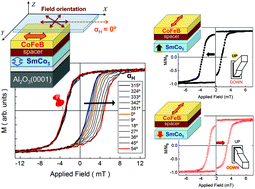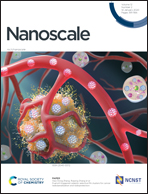An extraordinary chiral exchange-bias phenomenon: engineering the sign of the bias field in orthogonal bilayers by a magnetically switchable response mechanism†
Abstract
Isothermal tuning of both the magnitude and the sign of the bias field has been achieved by exploiting a new phenomenon in a system consisting of two orthogonally coupled films: SmCo5 (out-of-plane anisotropy)–CoFeB (in-plane anisotropy). This has been achieved by using the large dipolar magnetic field of the SmCo5 layer resulting in the pinning of one of the branches of the hysteresis loop (either the ascending or the descending branch) at a fixed field value while the second one is modulated along the field axis by varying the orientation of an externally applied magnetic field. This means the possibility of controlling the sign of the bias field in a manner not reported to date. Moreover, modulation of the bias field strength is possible by varying the thickness of a spacer between the SmCo5 and CoFeB layers. This study shows that the observed phenomena find their origin in the competition between the artificially induced anisotropies in both layers, resulting in a reversible chiral bias effect that allows the selection of the initial sign of the bias field by switching (upwards/downwards) the magnetization in the SmCo5 film.



 Please wait while we load your content...
Please wait while we load your content...